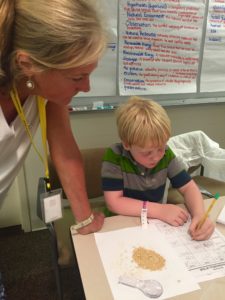Fall SAVY 2017, Day 3- Environmental Explorations: Dig It! (Kindergarten)
Dear Parents:
Our morning began with another story from 11 Experiments that Failed. This time, our author never got to test her experiment because of a failed plan. This gave us a chance to discuss our experiment last weekend with the black and white painted bottles, deflated balloons attached to the tops, and the question of which color would use more of the sun’s energy. We noted that we didn’t have full sun again today, but students were able to remember how the black bottle felt warm, and a couple of the black bottles appeared to be filling up with air more than the white bottles. I asked students to infer what the balloons would look like today if we had full sun. Students were able to infer that the black bottles would be filled with air. We sent home balloons for you to try the experiment at home when you have time to get 2 bottles (like Coke), paint one black and one white and attach the balloons to the tops to see what happens. We ran out of balloons for our last two scientists, so we will have them for those patient students next weekend.
We had a very busy morning of investigation and experimentation! Our focus this morning was natural resources, both renewable and nonrenewable, as well as soil and its importance as a natural resource. Students used the steps in the scientific wheel of investigation and reasoning to explore 5 different types of soil, using their sense of sight, smell and touch. Students were divided into 2 groups with Miss Emily and I guiding one each of the two groups. Students were given a sheet that allowed them to investigate the characteristics of 5 unidentified types of soil. They evaluated 1 unknown bag at a time. The types of soil were identified as A, B, C, D, E. Students worked with hand lenses, pencils (to separate the particles), and microscopes to decide how to describe the characteristics (first we defined what characteristics are), of the different soils in terms of sight, smell and touch. The conversations were amazing as our young scientists discussed the different characteristics. After thoroughly evaluating each unknown soil item, students attempted to decide which soil item belonged to each unknown. The choices were clay, topsoil, silt, sand and rock and gravel. The type that presented the biggest quandary was silt! Students described its characteristics as like baby powder, smooth, able to be flattened or pressed, etc. After students had finished their investigation and made their choices, we read the descriptions of each type of soil and after hearing the clues, students checked their selections with the answers.
After this investigation, students made a hypothesis about which type of soil they thought would hold the most water (porosity). We used coffee filters, mason jars and a beaker to measure how much water sifted through the soil type to the beaker. Students were involved in this experiment by helping pour the water and read the measurement that passed through the coffee filters. Students wondered why the topsoil (humus), stayed wet, yet passed water through! We will discuss our findings next week in more depth. If you have time at home, try this with a home plant that is planted in potting soil or organic soil, and let your student see what happens when they water the plant.
If you get some time this this week, let your young scientist take some soil samples from your yard, the set up the experiment they did in class to check the porosity of different soil samples from your yard. Ask students for advice on where you should place plants for best healthy growth.
I am looking forward to more learning.
Sincerely,
Mrs. Tyson

Leave a Response